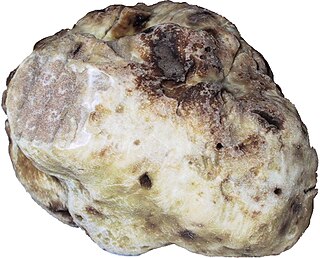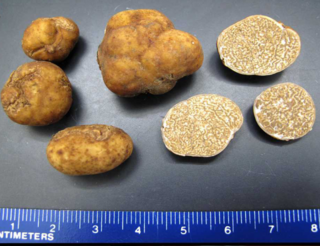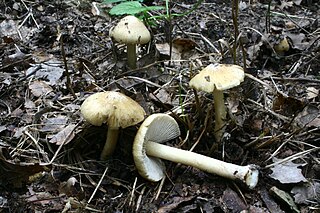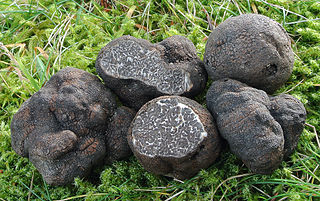
A truffle is the fruiting body of a subterranean ascomycete fungus, predominantly one of the many species of the genus Tuber. In addition to Tuber, over one hundred other genera of fungi are classified as truffles including Geopora, Peziza, Choiromyces, and Leucangium. These genera belong to the class Pezizomycetes and the Pezizales order. Several truffle-like basidiomycetes are excluded from Pezizales, including Rhizopogon and Glomus. Truffles are ectomycorrhizal fungi, so they are usually found in close association with tree roots. Spore dispersal is accomplished through fungivores, animals that eat fungi. These fungi have significant ecological roles in nutrient cycling and drought tolerance.
Fungiculture is the cultivation of fungi such as mushrooms. Cultivating fungi can yield foods, medicine, construction materials and other products. A mushroom farm is involved in the business of growing fungi.

Tuber magnatum, the white truffle, is a species of truffle in the order Pezizales and family Tuberaceae. It is found in southern Europe, the Balkans - and Thailand.

The gasteroid fungi are a group of fungi in the Basidiomycota. Species were formerly placed in the obsolete class Gasteromycetes Fr., or the equally obsolete order Gasteromycetales Rea, because they produce spores inside their basidiocarps rather than on an outer surface. However, the class is polyphyletic, as such species—which include puffballs, earthstars, stinkhorns, and false truffles—are not closely related to each other. Because they are often studied as a group, it has been convenient to retain the informal (non-taxonomic) name of "gasteroid fungi".

Tuber lyonii, also known as the American brown truffle or the pecan truffle, is a species of truffle native to North America. The pecan truffle is so named because it is most commonly found in pecan orchards, in association with the pecan tree. However, the pecan is not its only symbiote. Formerly considered nothing more than a nuisance by pecan farmers, the pecan truffle has been gaining in popularity as an edible mushroom in recent years and can fetch over $160 per pound at market.

Inosperma cookei, commonly known as the straw fibrecap, is a species of mushroom in the family Inocybaceae. It was first described in 1892 by Giacomo Bresadola, and is named in honour of Mordecai Cubitt Cooke. The species is found in Europe, Asia, and North America. It produces small mushrooms of an ochre colour, with a prominent umbo, fibres on the cap and a distinctive bulb at the base of the stem. It grows from soil in mixed woodland, and is encountered in summer and autumn, though is not common. Ecologically, it feeds through use of ectomycorrhiza. Inosperma cookei has been described as both toxic and non-toxic, but either way, is not advised for consumption.

Leotia lubrica, commonly referred to as a jelly baby, is a species of fungus in the family Leotiaceae. L. lubrica was first validly described by Giovanni Antonio Scopoli, but it was later transferred to Leotia by Christiaan Hendrik Persoon. Its relationship with other members of the genus, of which it is the type species, is complicated.

Tuber oregonense, commonly known as the Oregon white truffle, is a species of edible truffle in the genus Tuber. Described as new to science in 2010, the North American species is found on the western coast of the United States, from northern California to southern British Columbia west of the Cascade Range. A mycorrhizal fungus, it grows in a symbiotic association with Douglas fir. It overlaps in distribution with the closely related T. gibbosum, but they have different growing seasons: T. oregonense typically appears from October through March, while T. gibbosum grows from January to June. The fruit bodies of the fungus are roughly spherical to irregular in shape, and resemble small potatoes up to 5 cm (2 in) in diameter. Inside the truffle is the gleba, which is initially white before it becomes a marbled tan color. The large, often thick-walled, and strongly ornamented spores are produced in large spherical asci. The truffle is highly prized for its taste and aroma. Some individuals have claimed success in cultivating the truffles in Christmas tree farms.

Tuber is a genus in the fungal family Tuberaceae, with estimated molecular dating to the end of the Jurassic period. It includes several species of truffles that are highly valued as delicacies.

Kalapuya brunnea is a species of truffle in the monotypic fungal genus Kalapuya. The truffle occurs only in the Pacific Northwest region of the United States, in western Oregon and northern California. Known locally as the Oregon brown truffle, it was formerly thought to be an undescribed species of Leucangium until molecular analysis demonstrated that it was distinct from that genus. The truffle is reddish brown with a rough and warty outer skin, while the interior spore-producing gleba is initially whitish before developing greyish-brown mottling as it matures. Mature truffles have an odor resembling garlicky cheese, similar to mature Camembert. The species has been harvested for culinary purposes in Oregon.

Tuber lijiangense is a species of truffle in the family Tuberaceae. Found in China, it was described as a new species in 2011. Fresh truffles are pale yellow or light brown, roughly spherical, and measure up to 3 cm (1.2 in) in diameter.

Tuber sinoalbidum is a species of truffle in the family Tuberaceae. Known only from China, it was described as a new species in 2011. Fresh truffles are whitish with a similarly colored interior, and measure up to 4.5 cm (1.8 in) in diameter.

Tuber sinoexcavatum is a species of truffle in the family Tuberaceae. Described as a new species in 2011, it is found in China. The pale yellowish-brown to brown truffles measure up to 3 cm (1.2 in) in diameter. The species is named for its close resemblance to the common European truffle T. excavatum.
Tuber anniae is a species of truffle in the genus Tuber. The truffle is purported to be uncommon, but is primarily found in the United States Pacific Northwest. Recently the fruiting of closely related taxa have been found in the Baltic Rim countries, primarily forests dominated by Scots pine in eastern Finland.

Tuber melanosporum, called the black truffle,Périgord truffle or French black truffle, is a species of truffle native to Southern Europe. It is one of the most expensive edible fungi in the world. In 2013, the truffle cost between 1,000 and 2,000 euros per kilogram.

Tuber donnagotto is a species of truffle in the family Tuberaceae. Described as a new species in 2012, it is found in Croatia. The black truffle measures 2–7 cm (0.8–2.8 in) in diameter.

Tuber macrosporum, commonly known as the smooth black truffle, is a species of edible truffle in the family Tuberaceae. Found in Europe, and common in central Italy, the truffle was described as new to science by Italian mycologist Carlo Vittadini in 1831. The truffles are roughly spherical to irregular in shape, and typically measure 0.5 to 2 centimetres in diameter. The surface color ranges from reddish brown to rust to blackish. Warts on the fruit body surface are low, so that the truffle appears fairly smooth. The truffle flesh is purplish brown to grey-brown with thin white veins. It has an intense garlic-like odor similar to the Italian white truffle. Host plants of T. macrosporum include poplars, hazel, linden, and oaks.

Tuber indicum, commonly known as the Chinese black truffle or the Asian black truffle, is an edible fungus known for its hypogean fruiting bodies, characteristic of the Tuber genus. It is found natively in Himalayan India and parts of China, but has also been found invasively in the United States and Italy. It is sold commercially and often confused with Tuber melanosporum.

Sphaerosporella brunnea is a pryophilic species of small ascomycete cup fungi that commonly makes its habitat on burned substrates. Sphaerosporella brunnea is synonymous with Sphaerosporella hinnulea, Trichophaea brunnea, Peziza brunnea and numerous other fungi due to previously conceived variations in the fungi's habitat, substrate, and color ranging from dark brown to a light yellow-orange, however these differences were soon found to be negligible. S. brunnea is ectomycorrhizal, suspected to be saprobic, and is thought to be commonly widely distributed in Australia, Asia, the eastern United States and parts of Europe, such as Germany, Austria, Poland, the United Kingdom, and Sweden. This minuscule fungi is a detrimental contaminant in black truffle orchards, where Sphaerosporella brunnea seems to compete and inhibit the infection and growth of Tuber fungi, causing economic loss due to decreased infection rates of Tuber species.
















